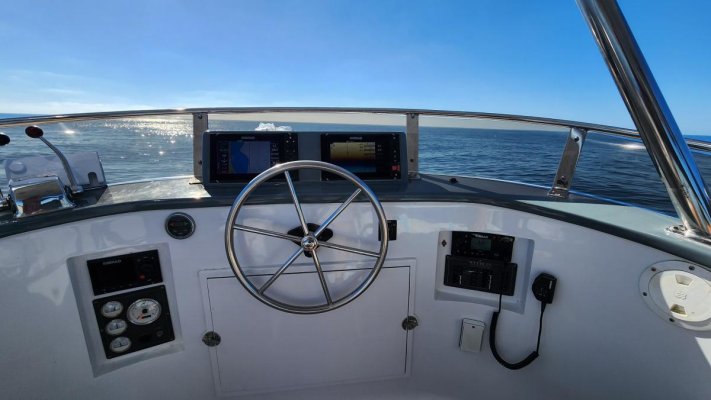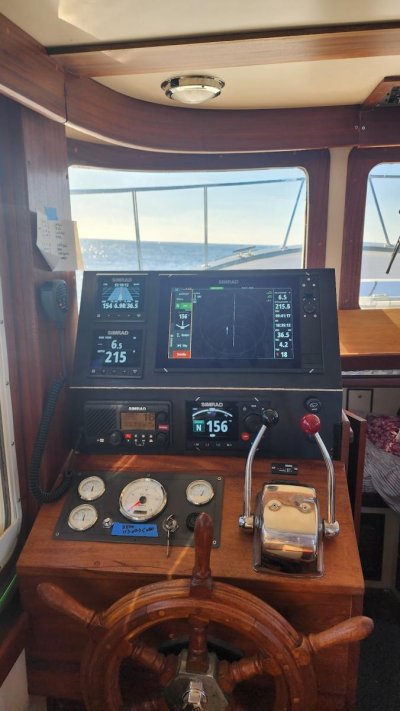PierreR
Guru
- Joined
- Oct 7, 2022
- Messages
- 502
- Vessel Name
- Mar Azul
- Vessel Make
- 1977 Hatteras 42 LRC
I am going to build an electronic system that I feel comfortable with in the near future. First a bit of background.
I have a 1977 Hatteras 42 LRC with 1,710 hours total since new. Yes dock queen to the max, covered slip, fresh water. Updating? Nada. Everything is old, most of it works, but nothing is bastardized either. The newest electronics on the boat are at least 25 years old.
I put 425 hours on the boat last spring bringing the boat home from Madisonville Louisiana, 3,300 miles via east coast and Erie Canal. I used common sense, a 45 year old depth sounder and an I pad with Navionics. I had no serious issues, no wait for parts breakdowns, never touched bottom or put a ding in the boat.
My ability to install or work on boat systems is highly skilled. My ability to operate boats is quite skilled and my ability to operate electronics and get the most out of them is on the order of Grandpa asking his 5 year old grandson to help him with his I phone. My information on boat electronics is quite dated.
I presently have two Autopilots, both functional A Wood Freeman 500 and a Furuno 5500. A Furuno GPS same vintage (useless) a Furuno 48 mile radar with 6' open antenna same vintage and a couple of vintage depth sounders. Half of the engine instruments don't work. The boat has its share of ground like related gremlins. I have an upper and lower helm.
I could likely install any system but not design it. I do not know what is actually available and what it does and I do not know what brands are more intuitive or robust.
The boat show is this Thursday and I would a least like some ideas of what to ask these electronic guys.
I would like a least new autopilot controls, GPS and depth sounders from both helms. Budget? $15 to $30k max.
I at least know that networks exist and things can communicate with one another. I also know that two paths exist. One of very simple systems that are easy to use and the path of high integration that presents everything simple and easy to use. Don't know enough to know what I don't know and therefore will be a Pidgeon at the electronics booths.
Help would be appreciated. If you overwhelm me I will say so and ask for clarification.
I have a 1977 Hatteras 42 LRC with 1,710 hours total since new. Yes dock queen to the max, covered slip, fresh water. Updating? Nada. Everything is old, most of it works, but nothing is bastardized either. The newest electronics on the boat are at least 25 years old.
I put 425 hours on the boat last spring bringing the boat home from Madisonville Louisiana, 3,300 miles via east coast and Erie Canal. I used common sense, a 45 year old depth sounder and an I pad with Navionics. I had no serious issues, no wait for parts breakdowns, never touched bottom or put a ding in the boat.
My ability to install or work on boat systems is highly skilled. My ability to operate boats is quite skilled and my ability to operate electronics and get the most out of them is on the order of Grandpa asking his 5 year old grandson to help him with his I phone. My information on boat electronics is quite dated.
I presently have two Autopilots, both functional A Wood Freeman 500 and a Furuno 5500. A Furuno GPS same vintage (useless) a Furuno 48 mile radar with 6' open antenna same vintage and a couple of vintage depth sounders. Half of the engine instruments don't work. The boat has its share of ground like related gremlins. I have an upper and lower helm.
I could likely install any system but not design it. I do not know what is actually available and what it does and I do not know what brands are more intuitive or robust.
The boat show is this Thursday and I would a least like some ideas of what to ask these electronic guys.
I would like a least new autopilot controls, GPS and depth sounders from both helms. Budget? $15 to $30k max.
I at least know that networks exist and things can communicate with one another. I also know that two paths exist. One of very simple systems that are easy to use and the path of high integration that presents everything simple and easy to use. Don't know enough to know what I don't know and therefore will be a Pidgeon at the electronics booths.
Help would be appreciated. If you overwhelm me I will say so and ask for clarification.



